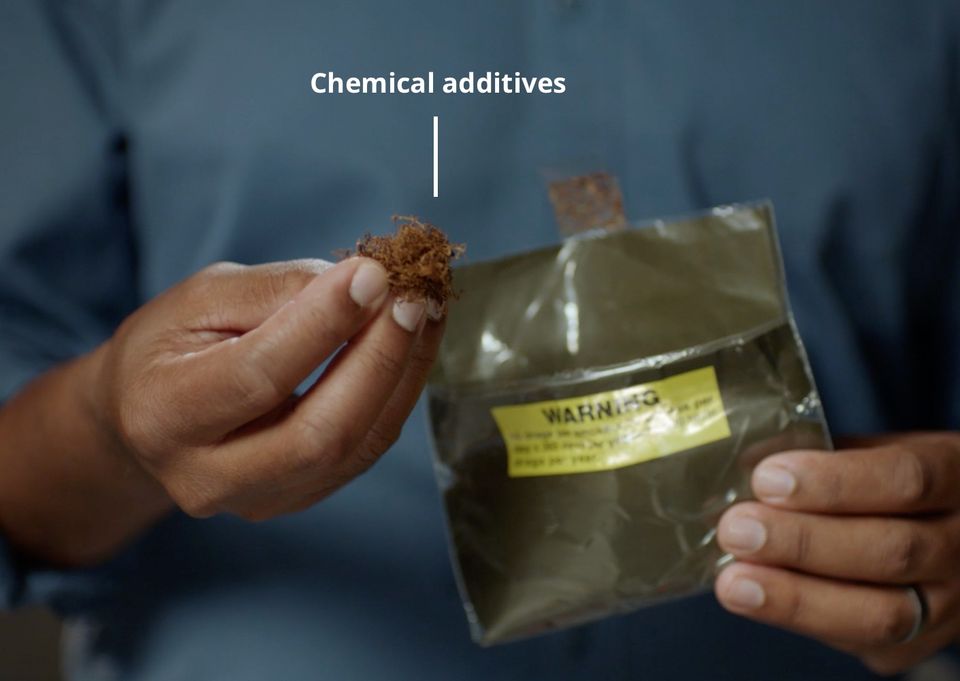All tobacco products are harmful. Tobacco smoke contains over 7,000 different chemicals. More than 200 of these chemicals are poisonous, and are released when the tobacco is burned. At least 69 are known to cause cancer. It doesn’t matter what tobacco product you use, or what the smoke tastes or feels like – all tobacco smoke is toxic to your body.
All forms of tobacco are harmful, whether it's rollie tobacco, tailor-mades, menthols or other forms. This is because some of the toxic chemicals in tobacco smoke come from the tobacco plant. Others form during the curing process, and others are added after this. Even more chemicals are formed once the cigarette is burned.1
Some of the dangerous toxic chemicals found in tobacco smoke include:
- Acrolein irritates your respiratory tract, weakens your immune system and causes serious heart damage and disease.2
- Formaldehyde is a chemical used to preserve dead bodies. It’s toxic to the airways and causes cancer.3
- Carbon monoxide causes heart damage.3
- Vinyl chloride is highly toxic, causing cancer and liver damage.3
- 1,3-Butadiene is a toxic chemical that damages the reproductive system and causes cancer.4, 5
- TSNAs (tobacco specific nitrosamines) cause cancer. Even small amounts are dangerous.6
Toxic chemicals are formed at every stage – from farm, to factory, to when a cigarette is lit
The growing tobacco plant
Some of the toxic chemicals in tobacco smoke are made in the tobacco plant as it grows. This includes nicotine, the addictive substance in tobacco. Others, such as lead and cadmium, enter the roots of the tobacco plant from the soil. Nitrates from fertilisers also build up over time in the plant. They are converted into many toxic compounds which are found in tobacco smoke.3
Curing and aging of the tobacco
After the leaves from the tobacco plant are picked, they are aged and dried out (called ‘curing’) so they can burn. During this curing and aging process, many of the natural chemicals from the plant break down. New chemicals are made as the old ones are altered. An example is TSNAs – tobacco specific nitrosamines, which can cause cancer.3
Chemicals added by tobacco companies
Tobacco smoke also contains chemicals that are added by tobacco companies during the manufacturing process. These chemicals include additives that make the tobacco moist, change the flavour of the smoke, and hide the harshness and irritation caused by the smoke.7
Burning the tobacco
It is when the tobacco is burned that many of the harmful chemicals in the smoke get made.3, 8, 9
An example is burned sugars. Sugars are a part of the tobacco plant and some additional sugars can be added during manufacturing. Once sugars are burned they create carcinogens, which are chemicals that can cause cancer.10

How are different tobacco products manipulated?
Tobacco companies manipulate tobacco products in ways that make the smoke feel less harsh and harmful than it really is. Click to find out how each of the products below are manipulated:
Escape the con
Inhaling the toxic smoke from raw dried tobacco would be extremely harsh and painful. Smoking is only bearable because tobacco companies mix in masking agents and other additives that hide the harshness of the smoke. They also manipulate the filter which makes the toxic smoke feel less harmful than it really is.
All tobacco smoke is full of the same toxic poisons – it doesn’t matter if the cigarettes you smoke are tailor-mades or rollies, menthols or non-menthols, or if they taste light or heavy, smooth or harsh.
The best way to escape this con is to quit smoking.
Frequently asked questions
What about heated tobacco products?
All forms of tobacco are harmful. The aerosol from heated cigarettes, also known as heat-not-burn, contains many of the same poisonous cancer-causing chemicals as cigarette smoke...
What about vapes?
While vapes don’t contain tobacco, they do contain hundreds of chemicals: some are known to be harmful to inhale and many haven’t been tested at all. Most vapes contain nicotine, which is highly addictive. People who vape are more likely to go on to smoke than people who don’t vape...
References
- Winnall WR. 12.4 Emissions from tobacco products, https://www.tobaccoinaustralia.org.au/chapter-12-tobacco-products/12-4-emissions-from-tobacco-products (2022, accessed 19 Sep 2022).
- Henning RJ, Johnson GT, Coyle JP, et al. Acrolein can cause cardiovascular disease: a review. Cardiovasc Toxicol 2017; 17: 227-236.
- U.S. Department of Health and Human Services. How tobacco smoke causes disease: the biology and behavioral basis for smoking-attributable disease. A report of the Surgeon General. 2010. Atlanta, GA: U.S. Department of Health and Human Services, Centers for Disease Control and Prevention, National Center for Chronic Disease Prevention and Health Promotion, Office on Smoking and Health.
- Hughes K, Meek ME, Walker M, et al. Concise International Chemical Assessment Document 30: 1,3-BUTADIENE: HUMAN HEALTH ASPECTS, https://apps.who.int/iris/bitstream/handle/10665/42367/9241530308.pdf?sequence=1&isAllowed=y (2001, accessed 19 Sep 2022).
- Fowles J and Dybing E. Application of toxicological risk assessment principles to the chemical constituents of cigarette smoke. Tob Control 2003; 12: 424-430.
- Hecht SS and Hoffmann D. Tobacco-specific nitrosamines, an important group of carcinogens in tobacco and tobacco smoke. Carcinogenesis 1988; 9: 875-884.
- Winnall WR. 12.6 Additives and flavourings in tobacco products, https://www.tobaccoinaustralia.org.au/chapter-12-tobacco-products/12-6-additives-and-flavourings-in-tobacco-products (2022, accessed 19 Sep 2022).
- U.S. Department of Health and Human Services. The health consequences of involuntary exposure to tobacco smoke: a report of the Surgeon General. 2006. Atlanta, GA: US Department of Health and Human Services, Centers for Disease Control and Prevention, Coordinating Center for Health Promotion, National Center for Chronic Disease Prevention and Health Promotion, Office on Smoking and Health.
- U.S. Food and Drug Administration. Harmful and Potentially Harmful Constituents (HPHCs), https://www.fda.gov/tobacco-products/products-ingredients-components/harmful-and-potentially-harmful-constituents-hphcs (2022, 19 Sep 2022).
- Talhout R, Opperhuizen A and van Amsterdam JG. Sugars as tobacco ingredient: effects on mainstream smoke composition. Food Chem Toxicol 2006; 44: 1789-1798.
